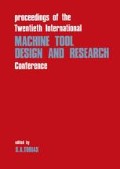Summary
Direct computer controlled shear spinning of conical, spherical, parabolic and sinusoidal shapes was performed with 5 inch (127 mm) diameter × 0.063 inch (1.59 mm) and 0.050 inch (1.27 mm) thick blanks of 1100-0 and 6061-0 aluminum. The DNC computer program permitted both easy contouring of the mandrels and the subsequent guidance of the spinning tool dynamometer for various axisymmetric shapes. Evaluation of axial spinning forces and final product thicknesses show that computer control of spinning variables can provide better production methods.
Access this chapter
Tax calculation will be finalised at checkout
Purchases are for personal use only
Preview
Unable to display preview. Download preview PDF.
References
S. KALPAKCIOGLU (1960) A Study of Shear Spinnability of Metals, ASME Paper No. 60, WA-187.
S. KOBAYASHI, ET.AL. (1961) A Theory of Shear Spinning of Cones, Trans. ASME, Series B, J. of Eng’g for Ind. Vol. 83, pp. 485–49.
B. AVITZUR and C. T. YANG (1960) Analysis of Power Spinning of Cones, Trans. ASME, Series B, J. of Eng’g for Ind. Vol. 82, pp. 231–245.
S. KALPAKCIOGLU (May 1961) On the Mechanics of Shear Spinning, Trans. ASME, Series B, J. of Eng’g for Ind. Vol. 82, pp. 125–130.
M. HAYAMA (March 1963) On the Study of Metal Spinning, Bulletin of the Eng’g Fac., Vol. 12, Yokohama Nat. Univ., Japan.
M. HAYAMA (March 1965) Theoretical Study of Tube Spinning, Bulletin of the Eng’g Fac., Vol. 15, Yokohama Nat. Univ., Japan.
R. A. PAULTON and B. N. COLDING (1958) Two New Industrial Processes for Plastic Deformation of Metals, Inst. of Mech. Engineers, Conf. on Eng’g Manufacturing Technology, Paper No. 57, London.
R. S. GECKLER (Sept. 1977) Metal Spinning Broadens Capabilities, Machine Design, pp. 92–95.
J. FRISCH (1972) A Conversational Mode for Direct Numerical Machine Tool Control, Proc. 13th Int. Machine Tool Design and Research Conference, England, pp. 161–166.
J. FRISCH and P. F. MAHR (1973) On the Use of Analog Digital Conversion During DNC-Metal Cutting, Proc. North American Metalworking Research Conf., Vol. 3, pp. 203–21.
J. FRISCH and E. MATA-PIETRI (1977) Metal Flow Through Various Mathematically Contoured Extrusion Dies, Proc. North American Metalworking Research Conf., Vol. 5, pp. 99–104.
H. WENDLER (Jan. 1979) Spinning, Shear and Flow Forming’s Advanced Look, Machine Shop, pp. 111–117.
Author information
Authors and Affiliations
Editor information
Editors and Affiliations
Copyright information
© 1980 The Department of Mechanical Engineering, University of Birmingham
About this chapter
Cite this chapter
Frisch, J., Achmad, M. (1980). An Experimental Study of Computer Controlled Shear Spinning. In: Tobias, S.A. (eds) Proceedings of the Twentieth International Machine Tool Design and Research Conference. Palgrave Macmillan, London. https://doi.org/10.1007/978-1-349-05172-4_3
Download citation
DOI: https://doi.org/10.1007/978-1-349-05172-4_3
Publisher Name: Palgrave Macmillan, London
Print ISBN: 978-1-349-05174-8
Online ISBN: 978-1-349-05172-4
eBook Packages: Springer Book Archive

